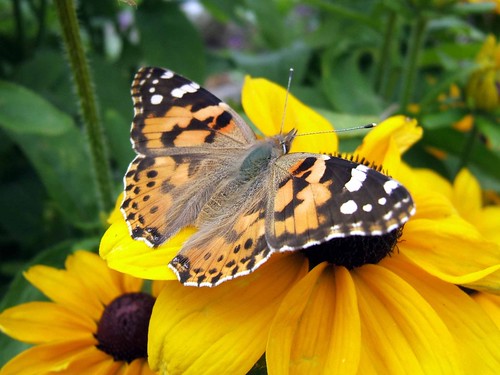So back to why this new style of planting is good - well lots of reasons. Many of the selected perennials are long flowering and nectar rich - lots of daisy, umbellifer and thistle type plants are mixed in. As you will hopefully have noticed from the pictures interspersed throughout this piece, nectar loving insects (and I'd assume if you were trying this in the USA hummingbirds?) love these plants and whenever I've visited these kind of gardens or nurseries there is a constant hum. Not only that but thy're low maintenance and good looking so hopefully will replace energy intensive (and unpretty) annual bedding schemes in parks and public spaces.
(Yet another Painted Lady on Rudbeckia 'Toto')
A lot of this goes back to a discussion I was having with someone recently. My point then was that it irritates me that wildlife gardening is perceived as a specialism that is different in some way from ornamental gardening in that wildlife gardens look nasty and are full of nettles. All gardens are wildlife gardens whether we want them to be or not as almost all plants are attractive to animals. Hopefully this newish style will get more people into gardening in a more wildlife-attractive way (even if they don't realise it). You don't have to just use native plants to get this effect either (although North Americans can probably create an awesome all-native garden in this style). Also as the planting is so thick and lush it naturally creates great hiding places for smaller animals. The level of work can be tailored too, at its simplest a prarie or meadow can result from sowing a seed mixture, for the more aesthetically minded a carefully planned Oudolf style scheme will take more planning.
Incidentally a nice bit of this stuff would make an excellent replacement for that lawn you hate mowing wouldn't it? - Check out Earth Home Garden blog and this Audubon magazine article for info on North American native planting style or hit google and do a bit of investigation.

2 comments:
Thanks for your very interesting posts. I remember as a child working in my uncle's garden in Essex - he grew lovely perennials and wonderful vegetables and fruit. I miss the fertile, rich English soil and abundance of water.
I completely "get" what you're aiming for - a hospitable habitat for welcome wildlife. Prairies and meadows won't work in our desert climate without overuse of precious groundwater, and our soil is only a shallow layer, with little in the way of nutrients, on top of a thick layer of caliche (a form of natural concrete). So in my case, I'm hoping to create a desert area and riparian oases. I'm starting with a small, bare patio and populating it with heat-loving plants that will be hospitable to our birds and butterflies - providing shade and nourishment for them. I'm avoiding plants that need a lot of water and plants that bring on allergies - usually these are non-native and have been brought to our area by people (sometimes a very long time ago) who missed the rose gardens, olive trees, mulberries, etc. of the "old country". I'm still a little bit shy of putting in a water feature, although I'm told it's something I should try. Maybe in a year so so, after I've learned more. The development will be slow; plants are expensive to purchase here and it's illegal to go and dig up the desert, although gathering seed is permitted. Wish me luck :)
As usual, your photography is magnificent.
There are so many ways to create a nature-friendly garden (which is still user-friendly) and it sounds like(and your blog shows) you're well on track.
Water always works (i'm rather jealous of some of the photos I've seen of birds enjoying Beth's tuscon fountain) but it is a major project.
Checking out your nearest "wild area" is always a great way to get ideas for the home garden
Post a Comment